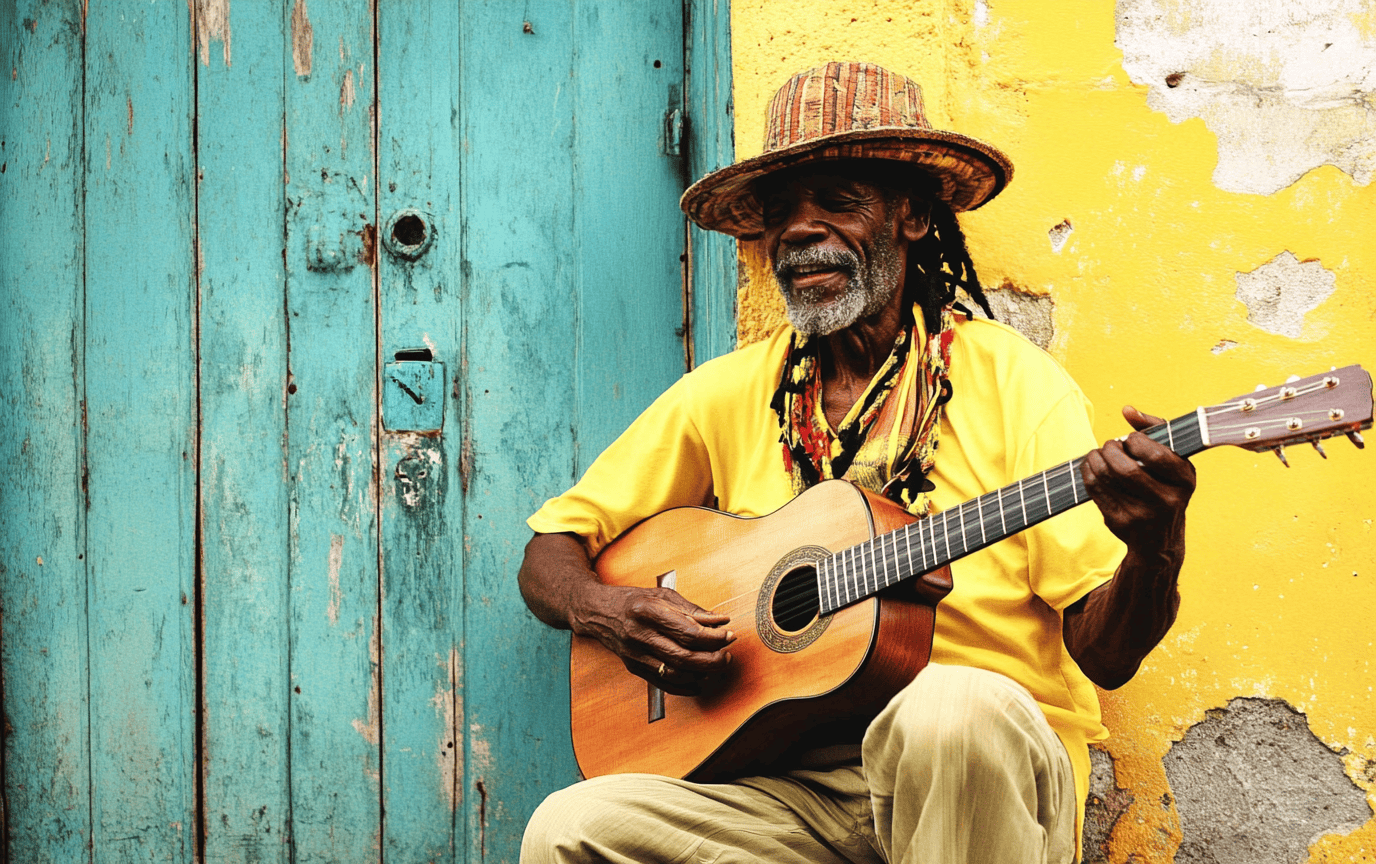Understanding the culture of Caribbean music: A vibrant tapestry
Caribbean music. Just three words, yet they carry stories of resilience, joy, and a panoramic view of history written in melodies and beats. Close your eyes for a moment. Listen. The sound of the steel drums, the rhythmic strum of the guitar, the pulsating heart of the djembe – they resonate deeply, echoing the struggles and triumphs of a people interwoven through generations. Travelers, what is it about Caribbean music that beckons to our souls? Why do these infectious rhythms awaken something primal within us? Let’s take an intimate journey to the roots of this vibrant culture, exploring its richness and nuances.
A journey back in time: African and European influences
As we trace back our steps to the vibrant shores of the Caribbean, we unearth a narrative steeped in history. The origins of Caribbean music unveil a canvas painted by both African and European influences. Enslaved Africans arrived on these shores, bringing with them a myriad of musical traditions forged in their homelands, from the polyrhythmic beats harvested from ancestral roots to the evocative call-and-response vocal patterns that became the spine of Caribbean expression.
But it wasn’t just the African heritage that contributed to this musical tapestry. European colonizers gripped the islands, introducing their own lineage of instruments – the sweet strum of the guitar, the melodic whispers of the violin, the bright undertones of the accordion. You can hear this blend in the pulsating beat of reggae, the playful jive of calypso, and the spirited stomp of soca.
Imagine gathering around a flickering fire as the starlit sky envelops you. Voices rise in harmony, storytelling through song, tracing a lineage that refuses to be forgotten. This is where the seeds of Caribbean music sprouted, and the rhythm of life began to echo louder.
Reggae music: The heart of resistance
Reggae. A word that rolls off the tongue like the sound of crashing waves against sunlit shores. This genre pulsed into existence in Jamaica during the late 1960s, originating as a blend of ska, rocksteady, and traditional mento. Reggae is a beacon for social commentary—each note, each lyric a sigh of lament for the oppressed and an anthem for the free.
When you listen closely, the voice of Bob Marley rises in the air, a spirit that channels the cries of the marginalized. Songs like “Redemption Song” whisper truths about liberation and remembering one’s roots. Reggae’s heart beats strong—I can almost see travelers swaying gently to its rhythm, thoughts drifting towards the panoramic scenes of lush landscapes and stark social realities.
“Let’s unify,” the lyrics chant, a call to arms wrapped in melody. The rastafari movement breathes life into reggae, imbuing it with philosophies of love, spirituality, and resistance. It is more than just music; it’s a way of life, a movement that transcends mere auditory experience to challenge the status quo.
Calypso music: The storyteller’s voice
As we dance into the vibrant history of calypso, we find ourselves in Trinidad and Tobago, where the essence of storytelling thrives. Calypso is marked by its infectious beats and wacky storytelling, often delivering powerful social commentary wrapped up in playful melodies.
Take a moment to envision a bustling street during Carnival. The air is thick with excitement. You can hear the distinctive sound of steel pans ringing out joyfully, as the crowd gathers to immerse themselves in song. This is calypso’s moment—a rhythmic saga unfolding as singers deliver sharp, playful jabs at politicians and societal norms. “Rum and Coca-Cola” resonates in the air, each note a brushstroke against the canvas of life.
From the early days of Emancipation, calypso served as a subtle peacekeeper, a means to voice concerns against oppression. But here, the artists didn’t just chronicle woes; they unfurled joy, exploration, and the nourishing aspect of Caribbean culture. The humor intertwined with incisive wit transports the listener to a bar beneath swaying palm trees, laughter spilling freely in the face of adversity. This is calypso—where celebration marches hand-in-hand with reflection.
Soca music: A carnival of sound
Yet, no exploration of Caribbean music would be complete without touching upon soca—a genre that emerged from calypso in the late 1970s. Imagine the electric rush of a live performance during Trinidad’s Carnival. The rhythm is fast-paced, uplifting, urging bodies to move, to celebrate. It’s a fusion of calypso and East Indian influences, with steel drums and vibrant melodies converging into an explosion of color, rhythm, and spirit.
Lord Shorty, the mastermind behind soca’s evolution, injected this genre with a lust for life. Soca ensnares you, binds you in an embrace of euphoria. It is not merely music; it is an experience that compels you to dance until dawn. Picture yourself in a parade of costumes, smiling faces, and the vibrant hum of the crowd. “Don’t stop, keep moving!” The essence of soca embodies the heart of Carnival—the liberation from daily burdens and an all-consuming passion for life.
Cultural significance: Music as identity
Travelers, Caribbean music is a profound cultural expression, continuously layering histories, voices, and identities. It serves as a chronicle, each song peeling back the layers of a heritage steeped in complexity and resilience. The annual festivals—Trinidad’s Carnival and Jamaica’s Reggae Sumfest—stand as monuments to the power of music in binding communities, where calypso and soca explode into jubilant celebration.
More than entertainment, Caribbean music embodies social commentary, forging connections among generations as stories of identity, struggles, and aspirations are intricately woven into the very fabric of the community. It molds dance, fashion, and art—reflecting the ebbs and flows of life. When you stroll down the streets of Port of Spain or Kingston, you can feel the pulse of life; it vibrates from shop fronts to street corners, beckoning you to join the narrative.
Impact on global music: A tropical ripple effect
Perhaps one of the most remarkable aspects of Caribbean music is its influence on global genres. From reggaeton in Puerto Rico to dub emanating from Jamaica, the footprints of Caribbean rhythms trace a wide path. Iconic figures like Rihanna and Sean Paul have fused Caribbean sounds with contemporary pop, further extending the reach of our beloved music.
As you listen to the latest hits, take a moment to discern the thread connecting contemporary artists back to their Caribbean roots. The lush soundscapes and infectious rhythms ripple through Spotify playlists, dance floors, and radio waves, serving as a reminder that while geography places limits, music knows no constraints.
In this way, Caribbean music stands as a testament to creativity’s power—a communal voice traveling across borders, connecting hearts and minds, invigorating life. And so, amidst driving beats and lyrical verse, it teaches us invaluable lessons: to love deeply, celebrate life, and fight for justice.
Conclusion: The unbreakable bond of music
Caribbean music is not just sound; it is an experience, a connection that transcends the physical realm. It tells stories of a rich heritage, rich with layers of complexity and identity, forever intertwined with the trials and triumphs of its people. As you listen, reflect on the journey—the heartbeat of reggae, the lively laughter of calypso, the electrifying energy of soca—each rhythm guides us deeper into understanding.
So, when you find yourself swaying to the rhythms of the Caribbean, understand you are partaking in something profoundly beautiful, a cultural ritual that spans continents and connects souls. We have traversed the fabric of history, music, and identity, learning that the allure of Caribbean music is not merely in the sound, but in the stories waiting to be heard.
Picture yourself swaying to vibrant beats under a tropical sunset, diving deep into the cultural heartbeat with experience paradise: your ultimate guide to escaping winter on Caribbean islands, tasting the island life through unlock culinary magic with cooking classes abroad, and planning an affordable getaway with tips from discover unbeatable budget travel hacks for 2025.
Interested in more insightful reads? Check out our Travel Tips section for the latest advice. For lifestyle inspiration, explore our Lifestyle category, and dive into amazing destinations at Destinations. Don’t forget to connect with us on YouTube, or follow our adventures on Instagram and Pinterest.













